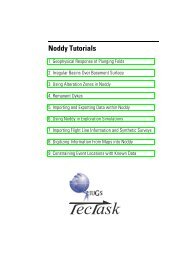Revised Eburnean geodynamic evolution of the ... - Tectonique.net
Revised Eburnean geodynamic evolution of the ... - Tectonique.net
Revised Eburnean geodynamic evolution of the ... - Tectonique.net
You also want an ePaper? Increase the reach of your titles
YUMPU automatically turns print PDFs into web optimized ePapers that Google loves.
S. Perrouty et al. / Precambrian Research 204– 205 (2012) 12– 39 15<br />
Fig. 2. Compilation <strong>of</strong> histograms presenting radiometric age data and <strong>the</strong> number <strong>of</strong> zircons/whole rock samples for <strong>the</strong> three main stratigraphic sequences and on granitoids<br />
in <strong>the</strong> study area (after Taylor et al., 1992; Hirdes et al., 1992; Davis et al., 1994; Hirdes and Davis, 1998; Oberthür et al., 1998; Loh et al., 1999; Pigois et al., 2003; Attoh et al.,<br />
2006; Feybesse et al., 2006; Adadey et al., 2009; Agyei Duodu et al., 2009). The age distribution in granitoids shows two distinct peaks that correspond to <strong>the</strong> Eoeburnean<br />
and <strong>Eburnean</strong> phases. Dots represent dated samples for igneous rocks or zircons ages for sedimentary rocks and <strong>the</strong>ir associated error bars.<br />
Allibone et al. (2002a) suggest that <strong>the</strong> <strong>Eburnean</strong> I (Eoeburnean)<br />
event was associated with a period <strong>of</strong> magmatism and metamorphism<br />
responsible for <strong>the</strong> Sefwi Group metavolcanics and TTG<br />
granitoid emplacement (Table 1) that correlates with <strong>the</strong> pre-<br />
<strong>Eburnean</strong> <strong>of</strong> Feybesse et al. (2006).<br />
The second phase <strong>of</strong> <strong>the</strong> <strong>Eburnean</strong> orogeny affects both <strong>the</strong><br />
Tarkwa Group and <strong>the</strong> Birimian Supergroup. The <strong>Eburnean</strong> II<br />
(<strong>Eburnean</strong>) event is associated with major NW-SE shortening (D2<br />
<strong>of</strong> Allibone et al. (2002a, b); D1 <strong>of</strong> Tunks et al. (2004)) that developed<br />
major thrust faults – including <strong>the</strong> Ashanti Fault – along with<br />
isoclinal folds in Birimian metasediments and regional scale open<br />
folds in <strong>the</strong> Tarkwaian sediments. These features are overprinted by<br />
thrusts that were reactivated during a phase <strong>of</strong> sinistral transpression<br />
that utilised <strong>the</strong> existing thrust architecture (D2 <strong>of</strong> Tunks et al.<br />
(2004); D3 <strong>of</strong> Milési et al. (1992); D3 <strong>of</strong> Feybesse et al. (2006)). At <strong>the</strong><br />
Obuasi mine, 100 m scale folds described by Allibone et al. (2002a)<br />
may have developed during (his D4–D5) shearing. This phase <strong>of</strong><br />
<strong>the</strong> <strong>Eburnean</strong> orogeny is associated with most <strong>of</strong> <strong>the</strong> hydro<strong>the</strong>rmal<br />
gold deposits in <strong>the</strong> region. Late <strong>Eburnean</strong> deformation has been<br />
observed in <strong>the</strong> Damang mine, where it is characterised by very<br />
open folding and minor brittle faulting (Tunks et al., 2004). The D3<br />
<strong>of</strong> Tunks et al. (2004) corresponds to ESE-WNW shortening associated<br />
with folds, quartz veins and a shallow dipping crenulation<br />
cleavage that overprints D2 reactivated thrust faults. In Damang,<br />
Tunks et al. (2004) observed a conjugate system <strong>of</strong> faults that strike<br />
NW-SE and cross-cut all previous structures. These features may<br />
correlate with more regionally extensive NW-SE faults recognised<br />
in existing maps <strong>of</strong> southwestern Ghana.<br />
The relationship and timing between <strong>Eburnean</strong> deformation and<br />
Tarkwaian deposition are contentious and not fully understood.<br />
Allibone et al. (2002a) suggested Tarkwaian sedimentation<br />
occurred before major <strong>Eburnean</strong> deformation and mineralisation.<br />
Leube et al. (1990) played down <strong>the</strong> significance <strong>of</strong> post-Tarkwaian<br />
deformation suggesting “tension-related folding by gravity” (Stage<br />
V <strong>of</strong> Leube et al. (1990, p. 157)) was responsible for Tarkwaian<br />
structures, requiring earlier events to have controlled <strong>the</strong> regional<br />
structural architecture and <strong>the</strong> distribution <strong>of</strong> gold mineralisation.<br />
O<strong>the</strong>r workers propose an intermediate position with Feybesse<br />
et al. (2006) suggesting Tarkwaian sedimentation developed in<br />
response to <strong>Eburnean</strong> shortening following a phase <strong>of</strong> tectonic<br />
accretion and magmatism. Fur<strong>the</strong>r, Ledru et al. (1994) considered<br />
<strong>the</strong> Tarkwa Basin to have initiated as a foreland basin during <strong>the</strong><br />
final stages <strong>of</strong> <strong>the</strong> <strong>Eburnean</strong> orogeny.<br />
2.2. Birimian series<br />
The Birimian series was first described by Kitson (1918) in <strong>the</strong><br />
Birim River (around 80 km east <strong>of</strong> <strong>the</strong> Ashanti Belt). Since this early<br />
interpretation, <strong>the</strong> Birimian stratigraphic column has been revised<br />
significantly, including more than one complete reversal. Before<br />
<strong>the</strong> application <strong>of</strong> absolute geochronology, workers described an<br />
Upper Birimian composed by metavolcanics on top <strong>of</strong> a Lower Birimian<br />
corresponding to metasediments (Kitson, 1928; Whitelaw,<br />
1929; Junner, 1935, 1940; Hastings, 1982; Ntiamoah-Agyakwa,<br />
1979; Kesse, 1985; Milési et al., 1992). Leube et al. (1990) and<br />
Eisenlohr and Hirdes (1992) suggested that Birimian metavolcanics<br />
and metasediments were synchronous. Sm/Nd analyses conducted<br />
by Taylor et al. (1992) required a reversal <strong>of</strong> <strong>the</strong> stratigraphy with<br />
<strong>the</strong> younger metasediments overlying <strong>the</strong> older metavolcanics.<br />
This relationship was confirmed by Loh et al. (1999) with U/Pb




